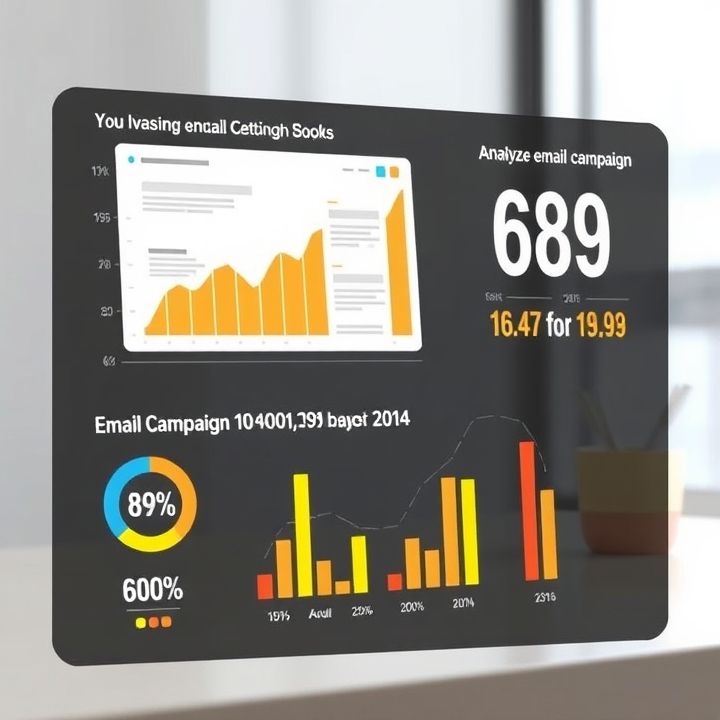Table of Contents
- Introduction
- Segmenting your audience for personalized messaging
- Crafting compelling and relevant email content
- Using automation tools for timely delivery
- Incorporating A/B testing to optimize performance
- Utilizing behavioral triggers for targeted emails
- Maintaining consistency in communication and branding
- Analyzing metrics to refine strategies
- Building relationships through value-driven content
- Conclusion
- Frequently Asked Questions
Introduction
In the rapidly evolving world of digital marketing, the ability to nurture leads efficiently has become a pivotal skill. Enter the world of email drip campaigns—an ingenious way for marketers to engage, nurture, and convert leads like never before.
Imagine a sequence of emails sent thoughtfully over time, designed to engage your audience and guide them through their buyer’s journey. With the right tactics, these campaigns can turn casual browsers into loyal customers. But how do you unlock the hidden potential of email marketing to boost your conversion rates effortlessly?
In this article, we dismantle the secrets behind successful drip campaigns, offering you proven tactics and strategies employed by top marketers. But first, let’s get an overview of what makes an email drip campaign stand out. Below is a quick glance at some of the core aspects we’ll cover:
| Key Element | Description |
|---|---|
| Personalization | Creating content that resonates with each recipient |
| Timing | Understanding when and how often to reach out |
| Content Creation | Crafting compelling emails that drive action |
| Analytics | Using data to refine and optimize campaigns |
Segmenting your audience for personalized messaging
Segmenting your audience is a crucial tactic for crafting personalized messages within email drip campaigns. By dividing your audience into distinct groups based on criteria like demographics, behaviors, or purchase history, you can tailor your content to meet the specific needs and interests of each segment. This ensures that your messages resonate more effectively with recipients, boosting engagement rates and conversion possibilities.
Start by analyzing data from previous interactions and categorizing your audience into meaningful segments. For example, separate new leads from repeat customers, or distinguish between different industries or geographic locations if applicable. Once segmented, develop customized content strategies for each group. Personalized messaging might include product recommendations, educational content, or exclusive offers, depending on the insights gathered about each segment.
Additionally, automation tools can help manage these segmented communication streams, ensuring timely and relevant delivery of emails. Personalization is not just about addressing the recipient by their name; it involves understanding their journey and offering value through well-considered, segment-specific content. This approach not only enhances customer satisfaction but also significantly increases the effectiveness of your email marketing efforts.
Crafting compelling and relevant email content
Crafting compelling and relevant email content is essential for the success of any email drip campaign. To begin with, it’s crucial to understand your audience’s interests, pain points, and preferences. Tailor your content to address these aspects, ensuring that each email provides value and resonates with the recipient. Personalized emails that reflect an understanding of individual customer journeys can significantly improve engagement.
Additionally, clarity and conciseness are key in email communication. Use catchy subject lines and keep the body content straightforward to capture attention quickly. Storytelling can be an effective tool, allowing you to connect emotionally with your audience while delivering the intended message.
Moreover, using strong and clear call-to-actions (CTAs) guides your readers towards the desired actions, be it visiting a website, downloading a resource, or registering for a webinar. A/B testing of various elements such as subject lines, content length, and CTAs can provide insights into what works best for your audience.
Finally, incorporating visually appealing elements such as images or infographics can enhance the email’s effectiveness while keeping the layout responsive for different devices ensures accessibility for all recipients. Constantly evaluating and optimizing your emails based on engagement metrics can further refine your strategy, leading to more successful conversions.
Using automation tools for timely delivery
Using automation tools for timely delivery of email drip campaigns is a highly effective tactic to nurture leads. These tools allow marketers to schedule emails to go out at optimal times, ensuring that content reaches the audience when they are most likely to engage. Automation platforms can segment audiences based on behaviors and engagement levels, customizing the drip campaign for each individual lead. This personalization increases the chances of keeping leads interested and engaged as they receive content that is relevant to their specific needs and interests.
Moreover, automation tools can handle complex tasks such as triggering emails based on predefined actions, allowing for a seamless experience that builds trust and relationship over time. By setting up triggers, such as opening an email or clicking a link, you can guide leads through the buying journey with precision. Additionally, these tools offer valuable insights through analytics, enabling you to track open rates, click-through rates, and conversions, which help refine strategies for better outcomes.
Overall, the use of automation in email drip campaigns not only saves time but also keeps the communication consistent and relevant, crucial for effectively nurturing leads and guiding them down the sales funnel.
Incorporating A/B testing to optimize performance
A/B testing, or split testing, is a crucial tactic in optimizing email drip campaigns. This method involves creating two versions of an email with one element varied, such as the subject line, call-to-action, or content layout, to test which performs better with your target audience. By analyzing open rates, click-through rates, and conversion rates for each version, marketers can gain insights into what resonates most with their audience.
The significance of A/B testing lies in its ability to provide data-driven results, allowing marketers to make informed decisions rather than relying on assumptions. It enables continuous improvement, ensuring that each email in the drip campaign is fine-tuned for maximum engagement and effectiveness.
Incorporating A/B testing into your email marketing strategy can also uncover surprising insights about subscriber behavior and preferences, ultimately enhancing the overall campaign strategy. By consistently testing and refining, businesses can not only improve immediate campaign results but also build deeper understanding and relationships with their audience over time. This systematic approach leads to better targeting, personalized content, and, ultimately, higher conversion rates.
Utilizing behavioral triggers for targeted emails
Utilizing behavioral triggers in email drip campaigns can significantly enhance your ability to connect with leads on a more personalized level. By observing actions such as website visits, clicks on previous emails, or social media interactions, businesses can tailor their messaging to the specific interests and behaviors of their leads. This targeted approach ensures that the content is not only relevant but also timely, increasing the likelihood of engagement and conversion.
Behavioral triggers allow marketers to send emails triggered by specific actions, such as downloading an eBook, signing up for a webinar, or abandoning a shopping cart. For instance, a user who frequently visits a particular product page can be reached out with special offers or additional information about that product. By doing so, companies can address potential questions or concerns, nurturing the lead throughout the decision-making process.
Moreover, by consistently analyzing lead behavior, businesses can refine their strategies over time, ensuring that their email campaigns remain relevant and effective. This ongoing process of monitoring and adjusting helps to maintain a strong connection with leads, ultimately guiding them towards a purchase decision while fostering long-term loyalty.
Maintaining consistency in communication and branding
Maintaining consistency in communication and branding is a crucial aspect of nurturing leads through email drip campaigns. When recipients receive emails that are cohesive in message and design, it builds trust and reinforces brand identity. This consistency ensures that your leads will recognize your company, regardless of the communication channel they encounter.
To achieve this, start by developing a set of brand guidelines that include your brand’s voice, tone, and visual elements like logos and color schemes. These guidelines act as a roadmap for creating emails that align with your brand’s overarching identity.
Each email should clearly communicate who the message is from and maintain a uniform style in terms of headings, font type, and imagery. By doing so, recipients will associate these elements with your brand, fostering familiarity and trust.
Additionally, ensure that the content is aligned with your audience’s expectations and interests, making it more likely they’ll engage with the emails. Consistency not only aids in brand recall but also nurtures the lead’s journey through the sales funnel by delivering clear and predictable messaging.
Analyzing metrics to refine strategies
Analyzing metrics is crucial for refining email drip campaign strategies, as it provides insights into what works and what doesn’t. The first step is to identify key performance indicators (KPIs) such as open rates, click-through rates (CTR), conversion rates, and unsubscribe rates. Each of these metrics offers valuable information about the campaign’s effectiveness.
Open rates can indicate the effectiveness of your subject lines and if your emails are being delivered successfully. CTRs are vital in assessing the engagement level of your content. A low conversion rate could suggest that better alignment is needed between the email content and the offer or landing page. Unsubscribe rates might point to the frequency of emails or content misalignment.
Once you have gathered enough data, it’s important to A/B test different elements of your emails, such as subject lines, content, visuals, and CTAs. This helps in determining what drives the best results and which areas need improvement. Continuously monitoring these metrics allows for dynamic adjustments and optimizations to better meet the audience’s preferences and needs, ultimately enhancing the effectiveness of your lead nurturing strategies.
Building relationships through value-driven content
Building relationships through value-driven content is an essential strategy for effective lead nurturing in email drip campaigns. By providing subscribers with content that is not only relevant but also valuable, businesses can establish trust and credibility. This approach involves sending targeted and personalized content that addresses the specific needs and interests of the audience. Rather than overwhelming recipients with promotional messages, value-driven content focuses on education, insight, and support.
One key tactic is to segment your email list based on demographics, behaviors, or purchase history. This allows for tailoring content to match the unique journey of each lead, enhancing engagement significantly. Additionally, incorporating storytelling into your emails can make the content more relatable and memorable, deepening the connection with the audience. Sharing case studies, testimonials, and success stories can demonstrate the tangible benefits of a product or service, while also instilling confidence in potential customers.
Moreover, consistently delivering high-quality, informative content positions a brand as an industry authority. Whether it’s through articles, videos, or infographics, providing actionable advice and thought leadership can lead to increased trust and loyalty. By prioritizing value-driven content in email drip campaigns, businesses can foster meaningful relationships and guide leads smoothly through the sales funnel.
Conclusion
In conclusion, email drip campaigns offer a strategic approach to nurturing leads effectively, ultimately driving higher conversion rates. By segmenting your audience and crafting personalized, compelling content, you ensure each message resonates with its intended recipient. Leveraging automation tools enables timely delivery and capitalizes on behavioral triggers, fostering more meaningful customer interactions. A/B testing further refines your strategy, allowing for data-driven improvements that align with your audience’s preferences. Maintaining consistency in messaging and branding not only builds trust but also reinforces your brand identity across communications. Comprehensive analysis of performance metrics is crucial for ongoing optimization, ensuring your campaigns are agile and responsive to changing customer needs. These tactics underscore the importance of delivering value-driven content, which serves to build lasting relationships and guide leads seamlessly through the buying journey. As you implement these proven tactics, your ability to nurture leads like a pro will undoubtedly yield significant returns, enhancing both engagement and conversion prospects in your email marketing endeavors.















